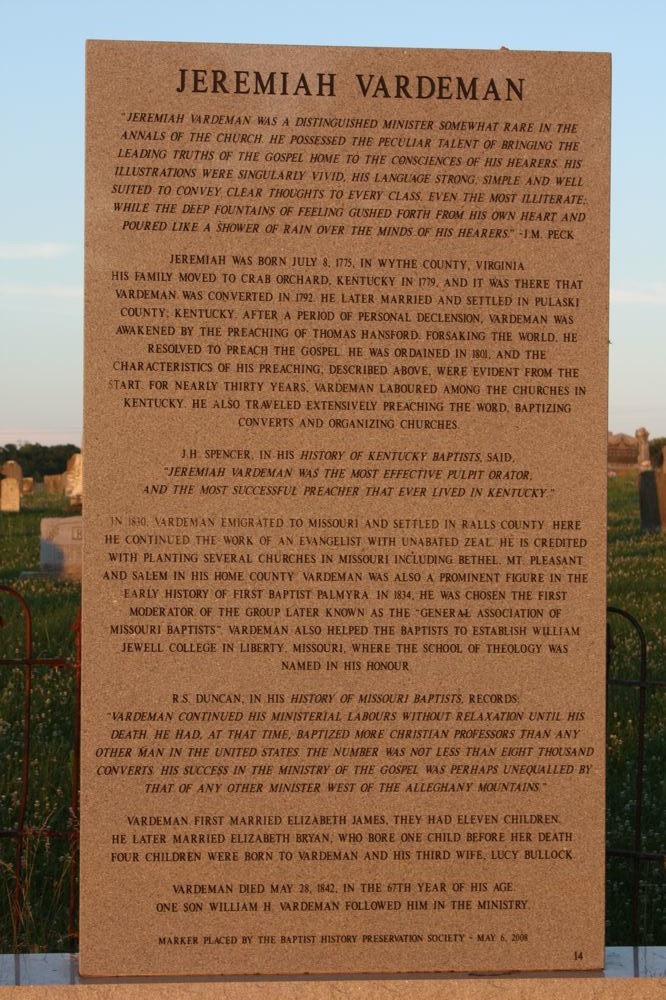Jeremiah Vardeman
1775-1842
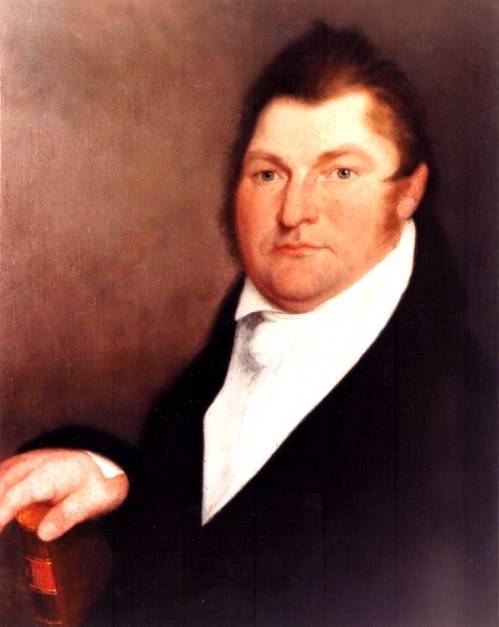
Contents
Jeremiah Vardeman And The Restoration Movement
Jeremiah Vardeman: From The Dance Hall To The Pulpit
Jeremiah Vardeman
Monument To Jeremiah Vardeman, Ralls County, Missouri
Jeremiah Vardeman - His Sepulchre Lieth Waste
Directions To The Grave of Jeremiah Vardeman & Grave Photos
Special Thanks
Jeremiah Vardeman And The Restoration Movement
Among the Baptists of Kentucky, Jeremiah Vardeman, was a household name in the 1820s and 30s. In the land that was still considered the wild west, new thought and new ideas permeated society. When the name of Alexander Campbell began to be heard among the peoples of the Western Reserve they were intensely interested in his fresh and strikingly Biblical thinking. His paper, the Christian Baptist, caught the attention and engagement of the greatest leaders among the Baptists such as Jacob Creath, Sr., Silas M. Noel, Philip S. Fall, John T. Johnson, "Raccoon" John Smith and Jeremiah Vardeman.
In October, 1823, Alexander Campbell rode his horse 300 miles from his Bethany, then Virginia, home to debate William L. McCalla. This Presyberian minister, with his empasis on pedo-baptism (baptism of babies), was terrorizing the Baptists of Northern Kentucky. He was said to be "smoke in their eyes and thorns in their sides." Campbell, having already debated the Presbyterian, John Walker in Mt. Pleasant, Ohio three years prior, was set to face McCalla in this second debate of his career. As the engagement approached, Campbell selected Jeremiah Vardeman to be his moderator. An interesting story related by Vardeman as he was on his way to Washington, Kentucky, the site of the debate, is related in the Memoirs of Alexander Campbell:
Jeremiah Vardeman was, beyond question, the most popular preacher in Kentucky. Although without much education, he had by his energy and zeal, and his fine hortatory powers, aided by his noble personal appearance and social qualities, acquired immense influence. He had heard many things about Mr. Campbell, and was anxious to see and hear him for himself. He used to relate afterward, that as he was on his way to the debate, traveling in a gig, he overtook, about eleven miles from Washington, a man on foot and hailing him, inquired whither he was going. He said he was on his way to Washington. “Why” said Vardeman, “you must have very urgent business to walk so far in such roads as these;” for, as it had been raining recently, the roads were very muddy. The man replied that he had no call of business, but that he was going to hear the debate that was to come off on the 15th. Surprised at this, Vardeman took him at once to be a very zealous Baptist, and affecting to be on the other side, he said: “Is not our man likely to whip your man Campbell?“ The man gave him a searching look, and asked: “Can you tell me if this is the same Mr. Campbell who debated with Mr. Walker at Mount Pleasant, Ohio?” Elder Vardeman said he believed he was. The stranger then said: “I am not a member of any church. I am going to the debate on the supposition that this is the Mr. Campbell who debated at Mount Pleasant three years ago. I heard that debate, and all I have to say is that all creation cannot whip that Mr. Campbell.” Elder Vardeman, who was noted for his power in defending the practice of immersion, was not a little gratified with this unexpected and very decided testimony to Mr. Campbell’s ability, and came on to the debate, full of cheerful expectation as to the fortunes of his favorite tenet. (Memoirs, vol.2, p.72-73)
For eight or nine years after the debate, Vardeman and Campbell developed a deep bond. They wrote back and forth to one another, and when Campbell visited Kentucky the preachers preached, taught, and socialized with one another. Campbell's teaching on baptism for the remmission of sins, introduced in the McCalla debate, began to be taught among many of the Baptists, including Noel and Vardeman. Reports were sent in to the Christian Baptist of great successes among the Baptists of Kentucky.
Being a man of great presence, Jeremiah Vardeman stood at about six feet tall and weighed around three hundred pounds. Another story Robert Richardson shared in Campbell's memoirs showed Vardeman's feelings about Campbell:
On the way to dine with a gentleman living in the vicinity, Mr. Challen was riding in company with Elders Vardeman and Creath, conversing about the strange light that had risen among them, when Mr. Campbell, on a fleet horse, overtook and passed them. Elder Vardeman then remarked: "I once thought I could preach, but since I have heard this man I do not seem, in my own estimation, to be any larger than my little finger." As he said this he held up his hand, and the comparison drawn from the contrast between the enormous bulk of the gigantic elder and his little finger, was at the time and ever afterward, when referred to, a source of great amusement to his companions. (Memoirs, vol.2, p.120).
In 1829 some of the Baptist Associations began making headway in defeating the influences of Alexander Campbell. Anathemas, or lists of characteristics of those who held to the teachings of Alexander Campbell, began to appear throughout the Western Reserve. The Beaver Decree and the Grand River Decree were practical ways a Baptist could detect as to whether a preacher was a true Baptist or if he was a "Campbellite." So, by 1830, as Campbell was being seen to be making a clear separation from the Baptists, the once strong relationship with Vardeman became very strained. Once when Campbell had been attacking the hireling preacher concept among the Baptists, it was reported by Jacob Creath, Sr., that Vardeman retorted, "if this thing takes, we shall all starve. The Baptists are not too liberal as it is." (Memoirs, vol.2, p.324).
In mid to late 1830, when Reformed Baptists in Kentucky were being excommunicated by the Elkorn and South Elkhorn Associations, Vardeman stood with Noel and others of the orthodox faith. Campbell, "later with affectionate regard, and often with the remark, 'I knew him well, and if I had been in Kentucky at the time, Jeremiah Vardeman would never have been persuaded to abandon the cause of the Reformation.'" (Memoirs, vol.2, pgs.325-326)
By mid-1831 Vardeman had left the state of Kentucky, never to return. Campbell surmized, "Mr. Vardeman's apostacy cost him his removal from Kentucky." (Millennial Harbinger, 1831, p.224) He moved to Ralls County, Missouri and preached among the Baptists in that country. His influence in Kentucky was not to be repeated in Missouri, as he was older and unable to be a far reaching with his mission. After about eleven years he passed to his eternal reward.
—Scott Harp
Jeremiah Vardeman:
FROM THE DANCE HALL TO THE PULPIT
In 1796, eleven year old John Smith was sent by his father from Wayne County's Stockton's Valley to Crab Orchard for the purpose of securing corn for food and for planting. Crab Orchard, Kentucky, located on the Wilderness Road, was approximately one hundred miles from young Smith's wilderness cabin. There he gazed for the first time upon the personage of three hundred pound Jeremiah Vardeman who was playing the fiddle for a dance. Destiny would have the courses of the two crossing many times in subsequent years.
"At the time Smith first saw Vardeman, the latter had been in the area for at least five or six years. In 1792 he had been baptized into the Cedar Creek Baptist Church at Crab Orchard. However, the fiddle and the dance soon resulted in his being dismissed from the church." {J.H. Spencer, A History of Kentucky Baptists, 2 Vols. (Printed for the author. 1886; reprint ed. Lafayette. Tennessee; Church History Research and Archive, 1976) Vol. 1. p.234} Vardeman was soon reclaimed by the preaching of the "unlettered" Thomas Hansford and quickly became the best-known Baptist preacher in Kentucky during the first quarter of the nineteenth century. He is best remembered for his "prodigious and unusually effective evangelistic preaching," rather than for work in a particular locality. Beyond his being very talented, he was gifted with a sonorous voice which permitted an "acre of people" to hear him clearly. {S.J. Conkwright History of Churches of Boone’s Creek Baptist Association (Winchester, Kentucky: by the author, 1923) p.71.}
At the annual meeting of the Cumberland Baptist Association in 1810, fourteen years after his first glimpse of the impressive fiddler, John Smith became formally acquainted with Vardeman. By this time Smith was twenty-six years old and had begun preaching at Pannleysville for the Bethel Baptist Church, which was located in the Horse Hollow section of Wayne County, Kentucky. Vardeman had heard of the talented country preacher and was looking forward to meeting him. Many years later, when reflecting upon this occasion, Smith remembered that the famous preacher "took me to himself as a brother." {John Augustus Williams, Life of Elder John Smith (Cincinnati, R.W. Carroll and Co., 1870), p.96}
The center of Vardeman's activities shifted to Central Kentucky during the year 1810. Even though his efforts focused primarily at David's Fork and Bryan's Station in Fayette County, he attended monthly the Grassy Lick and Lulbegrud churches in Montgomery County. Eventually he came to believe that Montgomery County was the area where the temperament and talents of John Smith could most successfully be applied.
In 1817, Smith yielded to the persistence of Vardeman to come to the care of the "destitute" churches of Montgomery. {Smith, p. 134.} This move to the Bluegrass Region. In effect, brought Smith into contact with a movement which consumed the country preacher from Horse Hollow. He spent the remainder of his life in Central Kentucky, and eventually, one-half century later, his mortal remains were deposited in her soil.
The popular Vardeman was requested, in the fall of 1823 to serve as moderator lor Alexander Campbell in the latter's debate with W. L. McCalla in the small town of Washington, Kentucky. Soon after the Campbell-McCalla debate, Vardeman accepted Campbell's position on baptism and declared it effectively for approximately five years.
Especially noteworthy was a meeting in Cincinnati in 1828. Alexander Campbell reported that in the September issue of the Christian Baptist that a correspondent informs that Bishop Jeremiah Vardeman arrived in Cincinnati the Friday before the 4th day in June, and immediately after his arrival he immersed 33, and had it not been for ill health, 10 more would have been immersed the same day. Thus in three weeks 118 persons were immersed in the belief of the gospel through the instrumentality of one individual proclaiming reformation towards God and faith in the Lord Jesus Christ. {Alexander Campbell, "Religious News," Christian Baptist Vol. VI, No.2 (Sept. 1828): p.47.}
In 1829, John Smith made an urgent visit to David's Fork in Fayette County where Vardeman was preaching. He had heard that his old friend had abruptly departed the Reformers and rejoined the Baptists. The visit was a most unpleasant one because his greatest fear was confirmed. {John Augustus Williams. Life of Elder John Smith (Cincinnati. R. W. Carroll and Co." 1870). p. 312-13.}
Soon after his rejoining the Baptists, Vardeman moved from Kentucky to Missouri and for twelve years worked rather diligently at promoting the Baptist cause in that state. He died in 1842 and was buried in a family grave plot on his farm. Unfortunately, his "sepulchre lieth waste." The stone of the famous preacher of yesteryear is broken approximately one foot above ground level and the portion containing the inscription is in fragments. {"Everett Donaldson. “Jeremiah Vardeman – His Sepulchre Lieth Waste,” the World Evangelist (June 1990): p. 5.}
—Everett Donaldson, 1991 Freed-Hardeman University Lectureship, Except, "Pages 103-105
Jeremiah Vardeman
Jeremiah Vardeman was the second pastor of Crab Orchard Church. He was probably the most effective pulpit orator, and the most successful preacher that ever lived in Kentucky. His father was a Swede, his mother a native of Wales. John Vardeman, Sr., with his young family emigrated from Sweden to South Carolina in the early part of the 18th century. He was a member of the Lutheran church, but joined the Episcopal Church, in South Carolina, and was esteemed for his piety and moral worth. His descendants reported that he died at the age of one hundred and twenty-five years.
His son, John Vardeman, jr., was also born in Sweden. He came with his parents to South Carolina when he was seven years old. He married Elizabeth Morgan, a native of Wales, in South Carolina. Soon after his marriage, he moved to Bedford County, Virginia. While living here, he and his wife professed religion and united with a Baptist church.
About 1767, he moved further west, and settled on New river, and ten years later, pushed still farther into the south-west corner of Virginia, and settled on Clinch river in what is now Russell county. Here he was compelled to move into a fort to protect his family from the Indians. But he did not long remain here. Again he moved on westward, and, in the fall of 1779, settled in Lincoln county, Kentucky, near the present town of Crab Orchard. This was two years before Lewis Craig settled on Gilberts creek, with his traveling church.
Here John Vardeman and his older sons were compelled to take part in the numerous wars with the Indians, that gave exciting and hazardous employment to the early settlers, for a period of nearly twenty years after his settlement in Kentucky. But he did not become indifferent to his religion.
He kept up family worship, and, when a church was organized near him, he became a member of it. He and his wife were probably members of old Gilberts Creek church, and it is certain that they were at an early period, members of the church at Crab Orchard, where many of their children afterwards became members.
The old pioneer remained near Crab Orchard, till 1812, when the country became too thickly settled to suit his habits of life, and he became restless and discontented, and again turned his face towards the setting sun. In October of that year, the church at Crab Orchard entered on its book of records an order, "that old John Vardeman have a letter of dismission." The term "old" was designed to distinguish him from his son, of the same name. With this evidence of his fellowship with the children of God, he moved to Missouri, where he died at the age of 109 years.
Jeremiah Vardeman was the youngest of twelve children born to John and Elizabeth Vardeman, and was born in Wythe county, Virginia, July 8, 1775. He came with his parents to Lincoln County, Ky, in the fall of 1779. Here he was raised up to manhood, in "the deep tangled wildwood," amid the constant dangers and privations of a frontier settlement, receiving barely education enough to enable him to read, write, and exercise in the simplest elements of arithmetic. After long continued and pungent convictions of sin, during which period his father and mother were his principal comforters and instructors, he obtained hope in Christ, about the year 1792. He immediately united with the church at Crab Orchard, and was baptized, probably by William Bledsoe, who was then pastor of that church. This was during the revival referred to above conducted by the Bledsoes, John Bailey and Peyton Nowlen. Mr. Vardeman always asserted that the preaching of these men had nothing to do with the awakening of his conscience. He was under conviction three months, during which the instructions of his parents, the prayers of his father, and his own reading of the Bible deeply impressed him.
When Mr. Vardeman, then about seventeen years of age realized the joys of salvation, he felt strongly impressed with the duty of warning sinners of their danger, and exhorting them to flee the wrath to come. This feeling preyed on his mind till he felt that he must preach. But many apparently insurmountable obstacles appeared in his way. He was young, timid, had not the gift of speech, and was uneducated. Still the subject bore heavily on his conscience. But he continued to resist the impressions till they measurable wore off. He continued very comfortable in the church, about two years, during which time he habitually prayed in secret, but did not attempt to pray or exhort in public. This was doubtless more the fault to the church and its unfaithful pastor, than of the young convert.
It is a sad truth, that many of our churches lose the talent, zeal, and influence of a large number of their best young members, by giving them nothing to do, in the Master's service. Every young church member should be proved, to ascertain his gifts, as soon as he becomes a member, and then be diligently employed in the work of the Lord, in accordance with his gifts. The pastor that fails to do this, is either incompetent to fill is position, or unfaithful to his charge.
Had young Vardeman been prudently brought forward in public prayer and exhortation, immediately after he joined the church, it would, no doubt, have saved five years of his invaluable services to the cause of Christ, and himself from piercing his own soul through with many bitter sorrows. But this was neglected, and he gradually wandered off into sin, and brought reproach on himself and the cause of Christ.
Some of his young associates made persistent efforts to draw him into the circles of frivolity. They finally succeeded by a misapplication of Scripture language, in convincing him that it was "no harm to dance," so far as to induce him to attend a "a frolic,' "just one time." He went once. Then again, and again, and finally engaged in the giddy dance. About this time Col. William Whitley, the well known pioneer and daring Indian fighter, permitted a dancing school to be taught in a large ball room, fitted up in the third story of his fine new residence. (In 1879 the author visited this ancient residence, which was still in a good state of preservation. It was located one and one-half miles west of Crab Orchard, and was occupied by the aged and pious Widow Penington, once a ward of Morgan Vardeman, brother of Jere.) "The young people were crazy about the dancing school." Young Vardeman was induced to subscribe himself a scholar, though, as he acknowledged, with a trembling hand and a smitten conscience. He was, of course excluded from the church. He soon afterward bought a violin, and having a taste for music, became "a good fiddler." During this period, he became enamored with Miss Elizabeth James, daughter of Richard James, and, became engaged to her. Her parents were pious members of Cedar Creek church, and, regarding Vardeman as a vain, frivolous young man, opposed the match. The result was an elopement and marriage. The young wife had made no profession of religion. Her parents had the good judgment to perceive that further opposition would be useless; they forgave the delinquents, and, with young Vardeman, moved to Pulaski County, on the waters of Cumberland river.
“There Vardeman became the leader of the young people in every species of mirth and amusement. None could sing and play on the violin so enchantingly, none so jovial and full of hilarity as Jeremiah Vardeman. He was the life and soul of every dance and country frolic, and his young wife, much to the grief of her father and mother, joined him in all these recreations. Thus nearly three years of his life passed away to no useful purpose. In a worldly sense he was not immoral. He never swore profanely, was temperate in drink; kind-hearted, generous and honorable in all his dealings with his fellow-men; his duty to God was wholly neglected, and he lived after the course of this world. Yet he was not a happy man. In the midst of his associates, in gayety, music and dancing, he was full of enjoyment; but conscience was then stifled. There were seasons of mental disquietude which none can realize, but those who have drunk the wormwood and gall, after a season of backsliding. Conviction of his sin and folly often drove him back to sinful pleasures for temporary relief.
His religious friends with the exception of his mother, had given him up, believing he would go on the downward course to the end. She continued in persevering prayer and unwavering faith, saying with deep emotion: "I know Jerry will be reclaimed; God is faithful, and I feel assured that he is a prayer hearing God."
There lived in Pulaski County a plain, illiterate preacher of the name of Thomas Hansford. He was an earnest, self-sacrificing man, and had the confidence of the people. Mr. Vardeman sometimes attended his meetings with his wife. On one of these occasions, Mr. Hansford preached from 2 Pet. 2:22: "But it is happened to them according to the true proverb. The dog is turned to his own vomit again and the sow that was washed to her wallowing in the mire." He applied the test to those who had professed religion and afterwards apostatized. The Spirit of God directed the truth with great pungency, to the conscience of Mr. Vardeman. He was deeply convicted of his backslidings. In speaking of it to Mr. Peck, many years afterwards, he said: "If brother Hansford had poured coals of fire on my naked body, it would not have burned me worse that that sermon did." His wife was convicted of her sins at the same time. They both went home with heavy hearts. Mr. Vardeman could not labor. For several days he spent most of his time in the woods, some times on his knees, and sometimes prostrated on his face, confessing his sins and crying to God for mercy. He repented bitterly of all his sinful frivolity, but his deepest conviction was for that sin which caused him to turn back to the world and commit all his other sins, his refusal to follow the impression of the Holy Spirit to preach the gospel, to call sinners to repentance. In his penitent anguish he cried out" "Lord, what wilt thou have me to do? I will do anything the Lord requires, if it kills me. He obtained some relief in reading and meditating on Malachi 4:2. "But unto you that fear my name, shall the sun of righteousness arise with healing in his wings, and he shall go forth and grow up as calves of the stall." He now vowed to the Lord that he would forsake all vain and worldly amusements and preach the gospel to his fellow-men.
A prayer meeting had been appointed at the cabin of one of Mr. Vardeman's neighbors. He with his wife attended this meeting the night after he had made the solemn vow just recorded. There was no preacher present, but there was so much interest felt that the people attended for several miles distant. It had been extensively rumored, without his knowledge, that Vardeman would preach. Before the meeting closed, one of Mr. Vardeman's neighbors, who was aware of his recent seriousness on the subject of religion, invited him to speak. He arose and commenced talking, but retained nothing of what he said, in his memory. He only recollected that the people of all classes were weeping and sobbing around him. Another social meeting was appointed for the next Sabbath. Mr. Vardeman again attended. He waited for older persons to take the lead, after which he rose up and with deep feeling and tears gushing from his eyes, delivered an exhortation, mingled with confessions of his own backslidings, and calling on his young associates to forsake their sinful amusements and follow Christ, and assuring them that they would then feel what he now felt-peace of conscience, and salvation through the blood and righteousness of Jesus Christ. To his surprise and amazement, young and old were crowding forward to give him their hand, and crying out: "Oh Mr. Vardeman pray for me, for I am a heap bigger sinner than you ever was." There were probably a score of people standing around him, and begging him to pray for them. He had never attempted to pray in public, but he thought of the vow he had recently made to the Lord, and he attempted to pray, for the first time in the hearing of others.
These social meetings were continued in a similar manner on each succeeding Sabbath, and two or three times in the week, except that Mr. Vardeman began to invite the people forward for prayer. Soon many of his former associates in sin gave evidence of conversion, and among the first was his wife.
News of the revival, of Mr. Vardeman's change, and of his preaching, as the people called it, soon reached Lincoln county. His parents, brothers and friends urged him to visit them. His first discourse there was solemn and effective. He seemed to want neither words nor matter. The church at Cedar Creek restored him to membership, and licensed him to preach. He preached several times in the neighborhood of Crab Orchard. The multitudes came out to hear him. In a short time upwards of twenty of his former associates in Lincoln County, and members of the dancing school that led him astray, professed conversion.
Mr. Vardeman was probably ordained in 1801, and the next year, moved back from Pulaski to Lincoln county, where he became pastor of four churches. He remained in this region of the State about eight years. Few particulars of his labors of this period have been preserved. But it is known that he was active in the ministry, traveled extensively, and was very popular and successful. The late Isaac Goodnight, Esq., of Warren county, who "cropped" with Mr. Vardeman in 1804, informed Mr. Peck that he was, at that period, pastor of four churches, and that during the year he made a preaching tour to Lexington, Maysville and several other places. In February, 1810, he was called to the oversight of David's Fork church in Fayette county, and in the same year resigned the care of, and took a letter of dismission from Crab Orchard church, and moved on a farm within the bounds of David's Fork. Under his ministry a revival soon visited his new charge and "within six months one hundred and seventy souls were added to the church." During another revival during his pastorate here in 1827-8 "upwards of two hundred precious souls were added to the church." He was pastor of this church twenty years and five months. He was three years pastor of Lulbegrud and Grassy Lick churches, both in Montgomery County. During this period he baptized for the fellowship of the former, one hundred and sixty-five, and for that of the latter, ninety. In 1811, he accepted a call to the pastorate of the missionary Baptist church at Bryant's Station, and occupied the position till 1830.
Besides his pastoral labors, Mr. Vardeman was a very active and wonderfully successful evangelist in Kentucky and several of the adjoining states, for a period of nearly thirty years before he moved to the West. In 1815, he visited Bardstown, where "Priest Baden was unwise enough to enter the list against him and lost several of his members. Next year he held meetings in Lexington and Louisville. In 1820, he visited Nashville, Tennessee, and through his labors the first Baptist church in that city was constituted, and attained membership of one hundred and fifty by the first of the following October.
In June, 1828, Mr. Vardeman held a series of meetings in Cincinnati, Ohio, which resulted in the baptism of 118 souls, in three weeks. These are only specimens of his abundant labors.
In the fall of 1830, he resigned the charge of all his churches and moved to Ralls County, Missouri. Here also, though advanced in years and grown corpulent, he did good service for the Master for a number of years. With the assistance of Elder Spencer Clack, who had recently moved from Bloomfield, Kentucky, he constituted a church in Palmyra. Several other churches grew up under his ministry.
In 1834, he presided in a meeting, convened for the purpose of organizing a system of domestic missions in the State. This organization grew in to the General Association of Missouri Baptists.
But soon the infirmities of old age began to creep upon him. Still he labored on up to the measure of his strength. For two years before his death, he was unable to stand up to preach, but sat in a large arm-chair. Only two weeks before he was called from earth, in company with another preacher, he visited the Sulphur Springs, at Elk Lick, for the benefit of his health. Before they left they constituted a church. On this occasion, Mr. Vardeman baptized five candidates for that ordinance. This was the last service of the kind he ever performed. "He had then," says Mr. Peck, "baptized more Christian professors than any [other] man in the United States. As he kept no register of these and other labors, the accurate number can never be ascertained; probably not less than eight thousand converts."
The last Sunday he spent on earth, he attended the appointment of another preacher, not far from his residence. After the sermon he spoke a half hour from the words: "How shall we escape if we neglect so great Salvation." He was, at that time free from pain, but during the week he grew worse, though little alarm was felt by his family. But on Saturday morning, May 28, 1842, he called his family around him, gave them some directions, bade them farewell, and gently fell asleep in Jesus, all within fifteen minutes. He was in the sixty-seventh year of his age.
In person Jeremiah Vardeman was handsome, commanding and attractive. Mr. Peck says of him, in his latter years: "His usual weight was three hundred pounds, yet his muscular frame was well proportioned and his personal appearance graceful and commanding. His voice was powerful, sonorous and clear, his enunciation distinct, and he could be heard in the open air for a great distance."
In doctrine he agreed with Andrew Fuller. In preaching, he was plain, simple and unaffected, yet wonderfully charming and attractive, pleasing alike the learned and illiterate. He was not what is termed a doctrinal preacher, and still less a controversialist. His descriptive powers were unrivaled, and in the force and power of is exhortation, he was probably never surpassed. In the whole manner of his preaching, he probably resembled the famous George Whitfield more than any other known orator.
-J.H. Spencer, History of Kentucky Baptists, vol.1, pages 232-240
back to topMonument To Jeremiah Vardeman, Ralls County, Missouri
A monument was placed at the Salem Baptist church in Ralls County, Missouri in May, 2008. It is dedicated to the life-work of Jeremiah Vardeman. He planted the Salem Baptist church. The Salem church/cemetery is not far from the Vardeman homesite. To visit this monument, traveling from New London SW toward Center on Hwy. 19, go six miles and turn left on County Road F (On some maps also Y). Go about a mile south and turn right on Salem Lane. The church/cemetery is on the NW corner. Go to the front of the cemetery, in the church parking lot, to see the monument.
GPS Location: N39º 30.545’ x WO91º 27.701
NOTE: The Vardeman's are not buried in this cemetery. Directions to the Vardeman Cemetery are below.
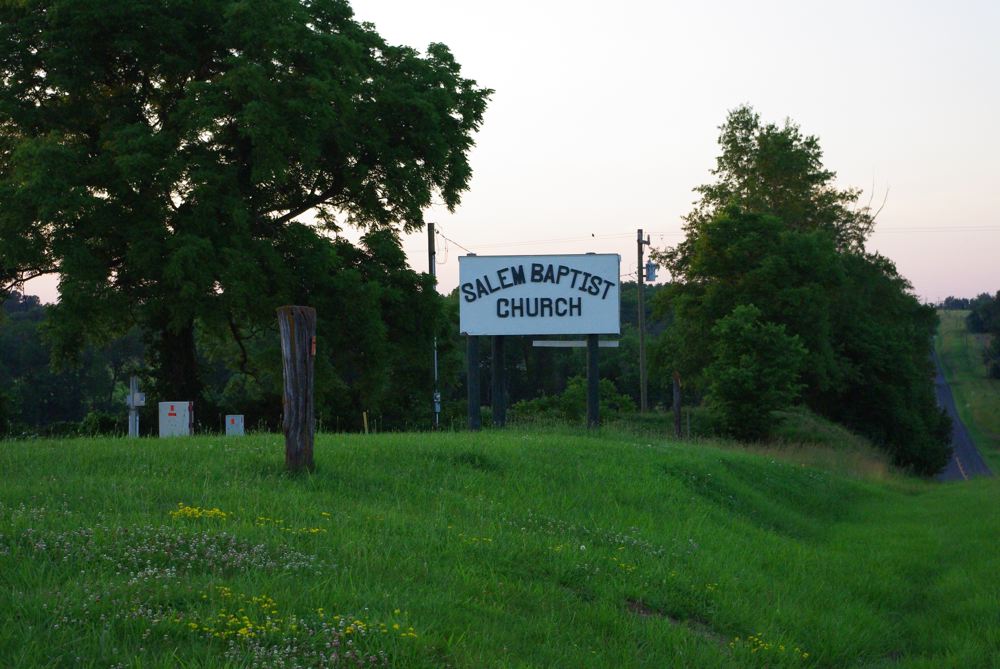
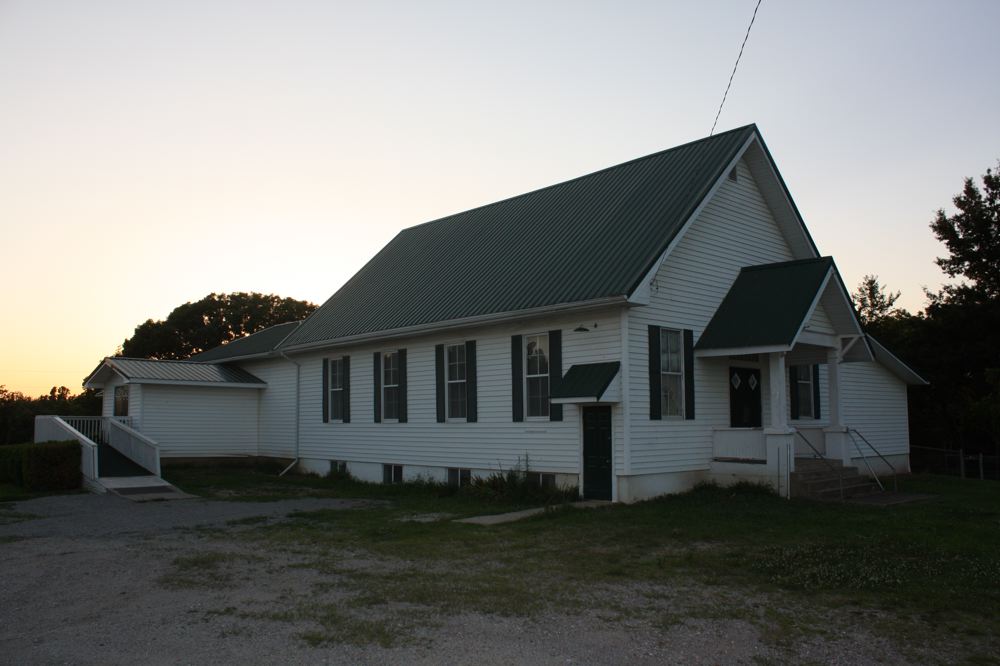
Old Salem Baptist Church
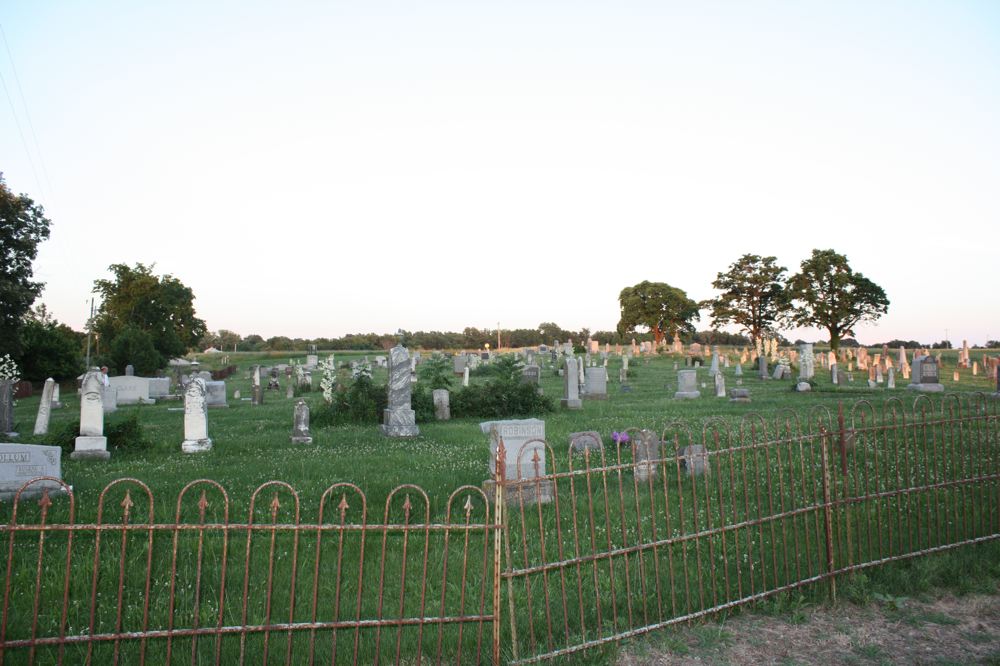
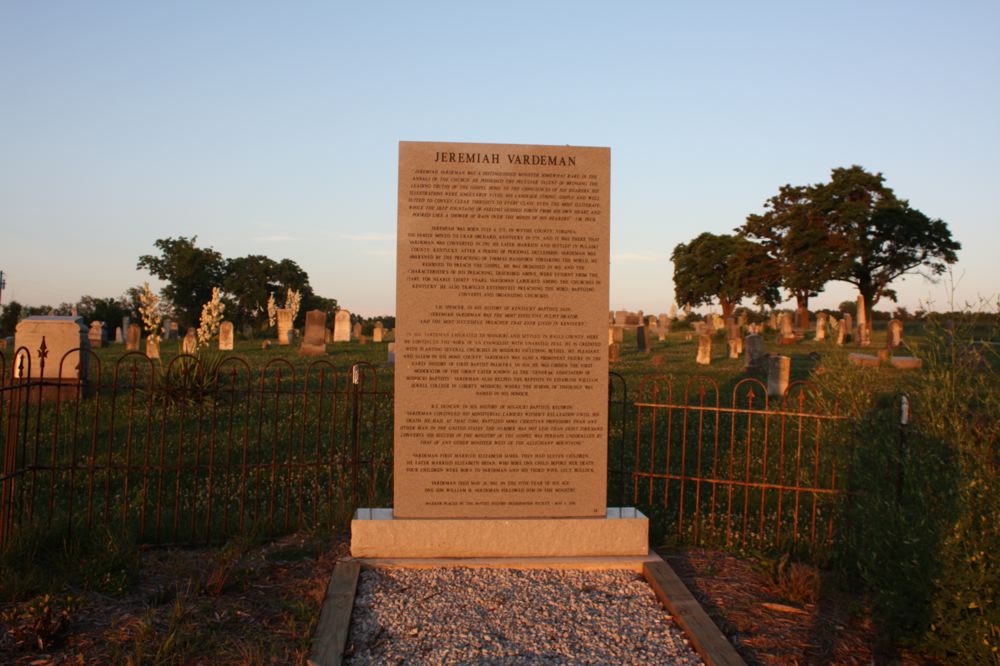
Jeremiah Vardeman - His Sepulchre Lieth Waste
A VERSATILE VARDEMAN
Jeremiah Vardeman was among the most interesting of prominent nineteenth century personalities associated with !be Restoration Movement Born in Virginia of Swedish ancestry, he remembered as a youth being involved in Indian fighting as his family moved west with the frontier. As a teenager he joined the Baptist Church at Crab Orchard, Kentucky while the territory was yet a county of Virginia. Subsequently, he was dismissed from the Baptist Church because of his fiddle playing and dancing.
Vardeman was eventually reclaimed by the Baptists and for the first quarter of the nineteenth century was their most effective evangelist in the Commonwealth of Kentucky. His usual weight was a well proportioned three hundred pounds and his voice was such that he could be easily heard by "an acre of people." It is estimated that he baptized six thousand people during his preaching career, many of whom were baptized between 1824-29 while fie was promoting the cause of "restoring the ancient order of things."
CAMPBELL AND VARDEMAN
During the decade of the eighteen twenties Alexander Campbell and Jeremiah Vardeman held one another in high regard. In 1823 the former chose the latter to serve as his moderator in the Campbell-McCalla debate. Of Campbell, Vardeman once said, "All the Baptist preachers in Kentucky put together would not make an Alexander Campbell."
An account by Campbell given in the September 1, 1828 issue of the Christian Baptist is indicative of Vardeman's success as an evangelist. He reported that during a meeting in Cincinnati "in three weeks, 118 persons were immersed into the belief of the gospel, through the instrumentality of one individual proclaiming reformation towards God and faith in the Lord Jesus Christ" Campbell also observed that: My correspondent further informs me, that, amongst the persons immersed, were the descendants of all denominations in that place, except Jews, 'viz. Baptists, Methodists, Episcopalians, Presbyterians, Universalists, Catholics, Deists, Swedenborgians, & c. Also, that they were collected from almost all the grades and occupations in society -- doctors, lawyers, judges, clerks, auditors, merchants, mechanics, and laborers.
PURSUING VARDEMAN TO MISSOURI
Interest in Jeremiah Vardeman is related to current research on Raccoon John Smith. Vardeman, wishing to see Raccoon John Smith "at work in a wider field of labor," persuaded him in 1817 to leave Horse Hollow in Wayne County and relocate in Montgomery County, Kentucky. This move placed Smith where he eventually became one of the most effective preachers in the Restoration Movement.
Very soon after departing from the principles of the Restoration Movement, in 1830 Vardeman moved to Ralls County, Missouri. In search of additional information on the Vardeman family. In December of 1989 my wife and I went to the area of Missouri where the Vardemans settled one hundred sixty years ago. With the assistance of a native who is knowledgeable of cemeteries in the area, we were successful in locating the Vardeman family farm and grave plot.
Reliable sources relate that in Missouri Vardeman worked rather diligently at promoting the Baptist cause. In fact, in 1835 he was the moderator when the forerunner of the Missouri Baptist General Association was formed. Records in the courthouse in New London, Missouri also revealed that before his death Vardeman had accumulated approximately one thousand acres of land. His will contains some very interesting provisions for distributing his holdings among his many descendants.
GRIEF, DEATH AND NEGLECT
In addition to his religious frustrations, Vardeman was often "a man of sorrows and acquainted with grief." His sixteen children were by three different wives. The first a mother of eleven, died in 1818: In 1821 he remarried, but after the birth of one child, his second wife died in 1822. By his third wife, who was twenty-seven years younger than he, four more children were born.
Previous to Vardeman's body being placed in the family burial plot, he had been preceded in death by four daughters within a six year span. Their ages ranged from thirty years down to a one year old daughter of his old age. The last, a youth of only sixteen years, died only ten days before her father. On May 28, 1842, the durable old patriarch died at the age of sixty-seven.
Contrary to that which existing secondary sources lead one to believe, Vardeman is not buried in Palmyra, Missouri, nor is it likely that he died there. In all probability he died at home with his family gathered around him. The cemetery in which Vardeman's grave site is located is in an open field about one fourth of a mile from the original site of the Vardeman residence. The farm, located approximately six miles west of New London, Missouri, is no longer in the Vardeman family and the graveyard has been unattended for many years.
The headstone of the famous frontier preacher is broken off about one foot above ground level and the portion containing the inscription was buried. It was discovered only after much searching and when the debris which covered the stone was removed it was retrieved in several pieces. Indeed, like the tombs of the fathers of the exiles in Nehemiah's time, his "sepulchre lieth waste."
WHAT MIGHT HAVE BEEN
Standing among the damaged tombstones one is induced to reflect upon what might have been. First, had Vardeman not been deterred from the pursuit to reestablish the first century order of things, along with Restoration preachers such as John Smith, he would have been remembered with much respect. When Alexander Campbell learned of Vardeman's defection, it is reported that he observed that "had he been in Kentucky Jeremiah Vardeman would not have gone back." In retrospect, one would fervently wish that Campbell had been in Kentucky at the appropriate time to have influenced Vardeman.
Secondly, it is incomprehensible that the Vardeman descendants and the Baptists have permitted the last physical manifestation of one of their most notables to fall into decay and disintegration. Considering the emphasis placed upon the Restoration Movement by those who wish to restore the first century order, and considering the high esteem in which the sacrificing pioneer Restoration preachers are held, it is believed that had "Ol' Jerry" remained faithful to the principles of the Restoration Movement, his sepulchre today would not be lying in ruins.
-Everett Donaldson, World Evangelist, Volume 18, No. 11, June, 1990, page 5
Webeditor Note: I thought the above article was apropos for several reasons. As I, along with Wayne Kilpatrick and Tom Childers, visited the Vardeman family cemetery in June, 2009, we can vouch for the severity of the present disarray of their small field of rest. Sadly, the cemetery is not fenced in, so cattle are free to graze in the middle of it, spelling disaster for any preservation. The pictures below will further describe the situation. Additionally, it was only days after our return from the trip that we heard the news of the death of Everett Donaldson. He had died the 9th of June, 2009 in Mt. Sterling, Kentucky. For years Donaldson studied the Baptist Reform movement in Kentucky, and was an avid student of “Raccoon” John Smith and Jeremiah Vardeman. He wrote two books on Smith’s life, wrote many articles including the one above, and appeared on numerous forums to lecture on the history of the Restoration Movement. Everett will be missed, but how pleasant to know that he now joins many of those whom he spent his life getting to know only through historical research.
Directions To The Grave of Jeremiah Vardeman
GPS Location
N39º 33.983’ x WO91º 30.134’
Grave Faces West – Acc. 27'
The Vardeman Family Cemetery is located in Ralls County, Missouri. Most online directions are vague, e.g. "Township 55S, Range 5 East, Section 7." However, it is better described as being located approximately 6 1/2 miles west of New London on the Vardeman property.
NOTE: The Vardeman burial plot is on private property. It is owned Mrs. Becky Leake. You will want to get permission from her to go to the grave.
Directions: From New London, head six miles toward Center on Hwy. 19. Turn right on Homestead Rd. Go ½ mile and you will see, straight ahead, the Leake home. After permission, head another 2 ½ miles out this road (it will zig-zag along the way) and then turn left on a private gated road. It usually stays locked. Go through the gate, then 6/10ths of a mile to a barn, and park.
Where the old barn sits is the old homeplace of Jeremiah Vardeman. The house stood until the 1970s. Now the barn is there. The stone house to the right was used as a cooking area, but in the early days of Ralls County, the upstairs part was used as the earliest jail in the county, according to the land owner, Becky Leake. The cemetery is through two fence-rows in the field to the right and of the stone building. Cross through the entrance (barb-wire fence) into the pasture. (There were cattle, and a pretty big bull in the field when we visited. Don't bother them, and they probably will not bother you.) Heading into the field, you will see down to your left is a pond. Travel down toward the pond and travel around to the right of it. Continue heading toward the NW corner of the pasture. Behind the corner and to the left is the Vardeman Cemetery. (Another fence to cross! Sorry!!) When we were there in June, 2009, we had to shoo cattle out of the graveyard in order to get to it. We instantly felt Donaldson's sentiments as mentioned in the article above.
![]()
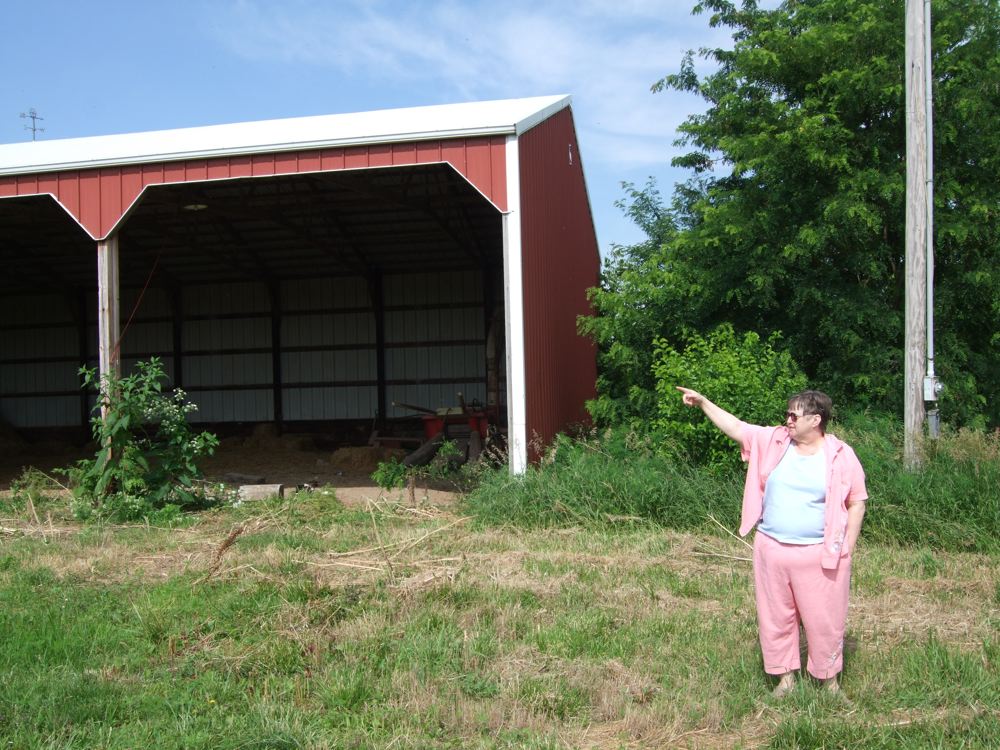
Becky Leake, The Present Owner Of The Property Helped Us Locate The Vardeman Cemetery
This was an old Hemp Farm for a while, and you can see clumps of mariguana still growing in the field wild.
The barn behind Mrs. Leake is the location of the Vardeman home that stood until the 1970s.
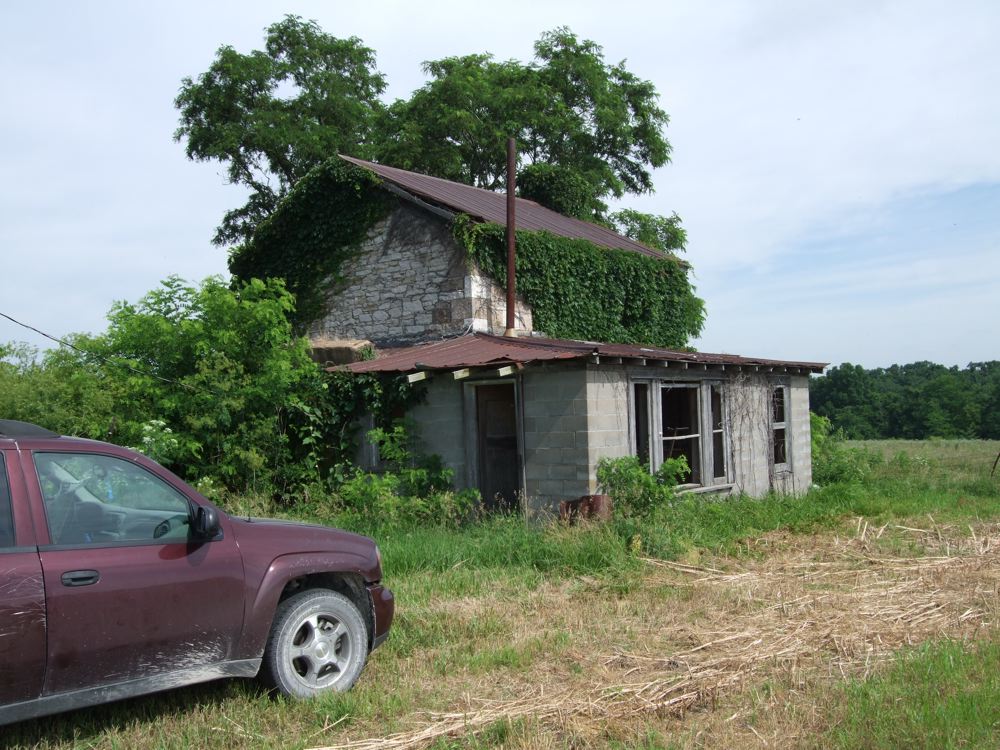
Front & Rear Of The First Ralls County Jail Upstairs - Vardeman Kitchen And Cooking Area On Ground Floor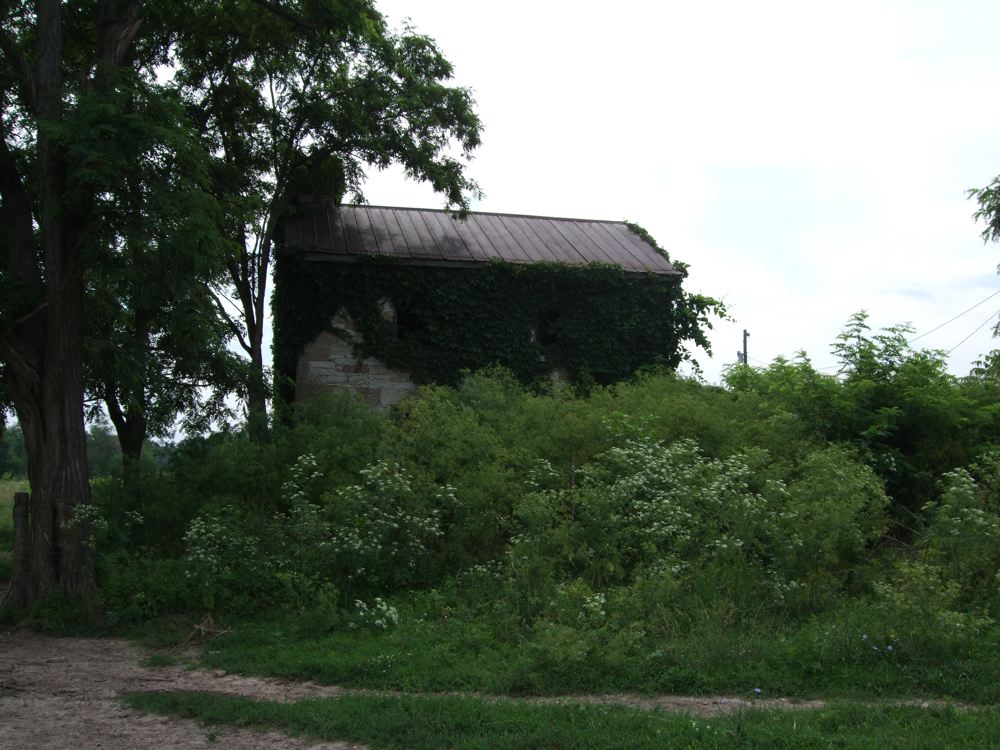
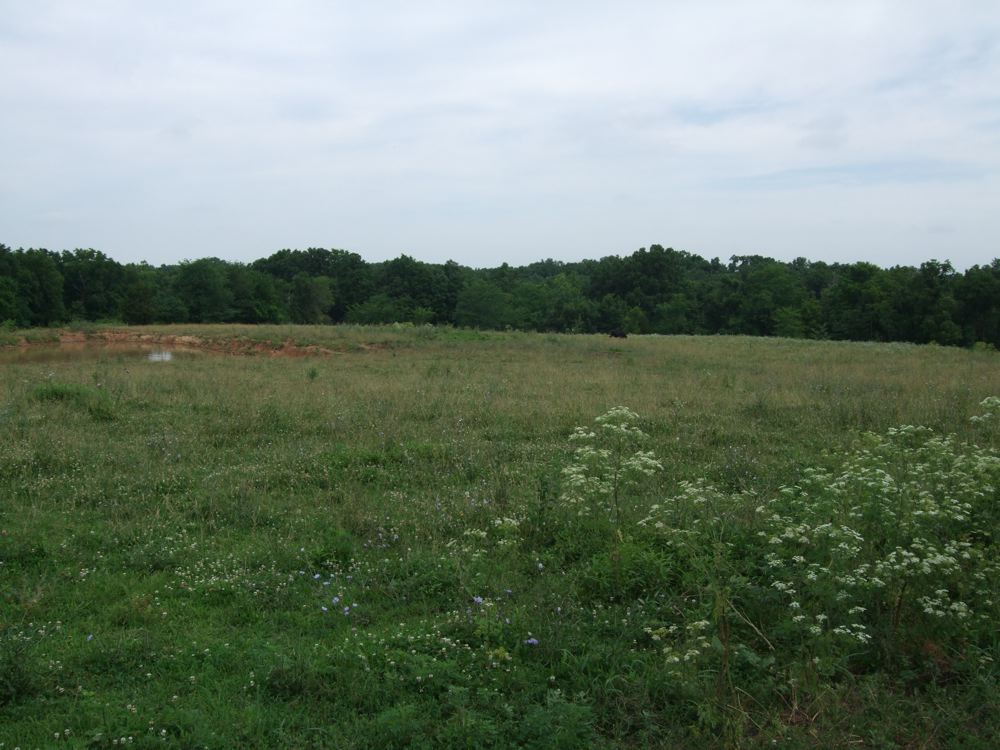
Bear To The Right & To The NW Cnr. Of This Field To Find Vardeman Cemetery
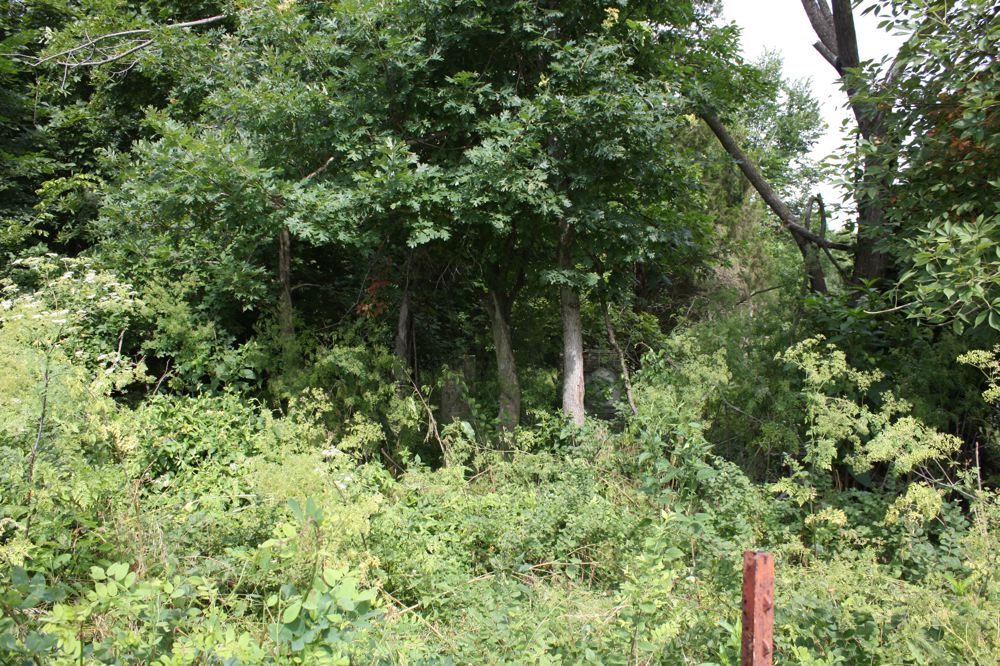
From The Field, Looking Into The Cemetery From Across The Fence
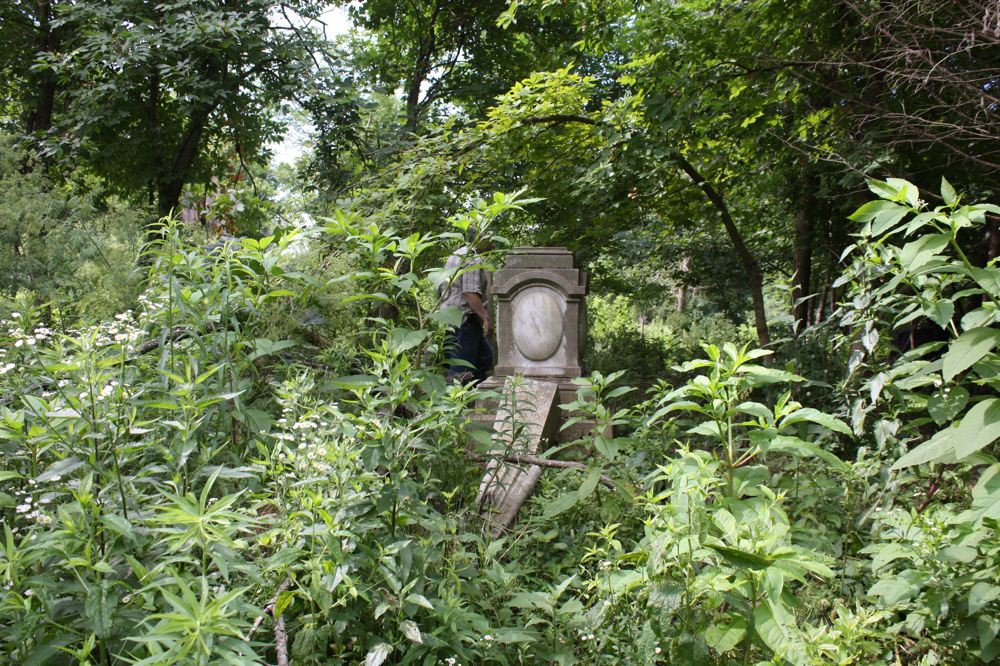
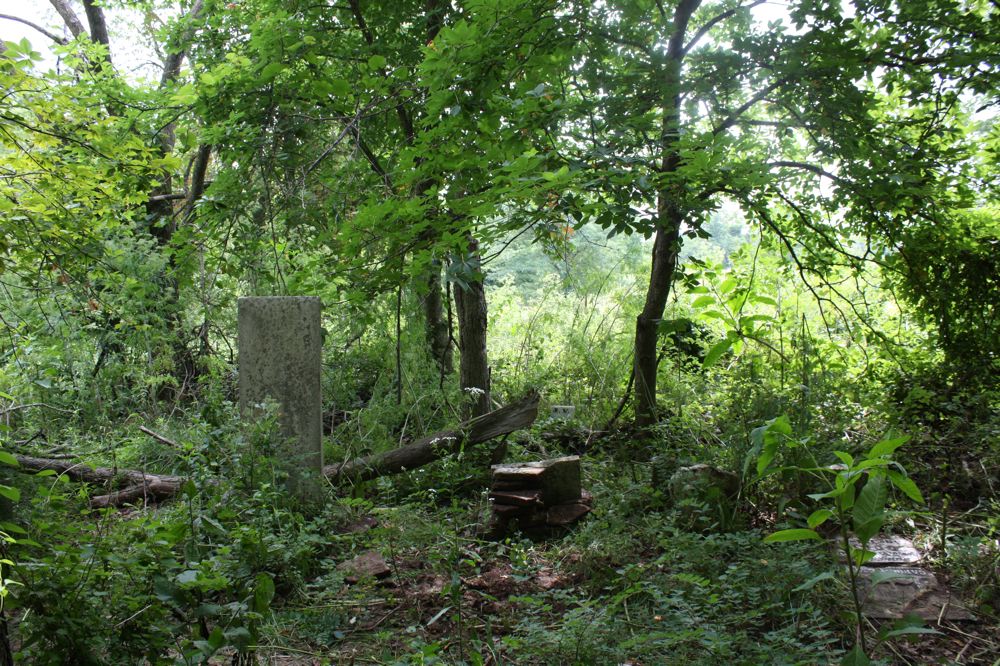
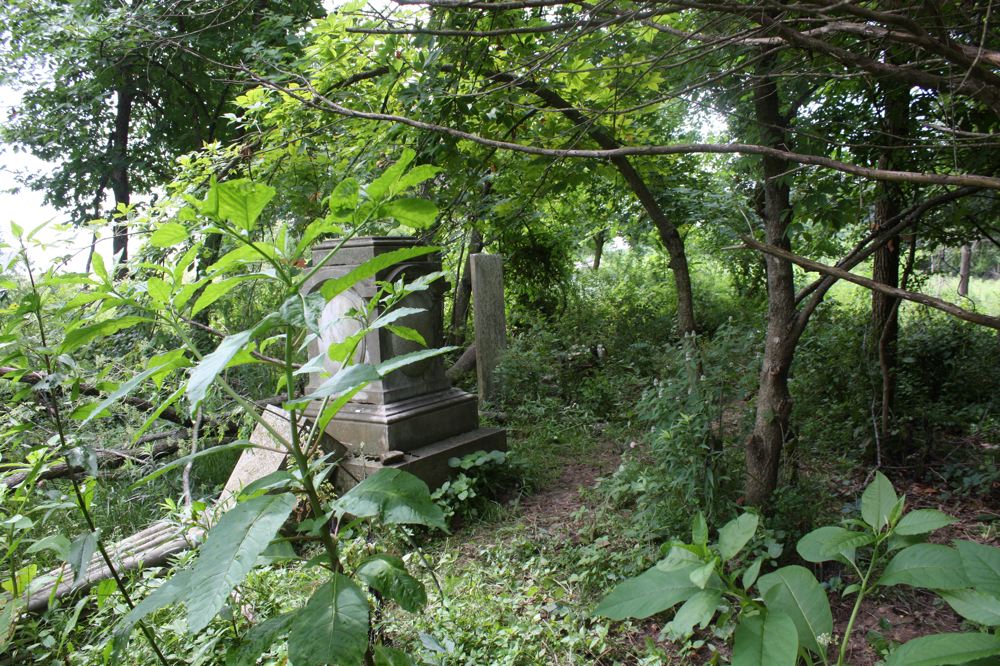
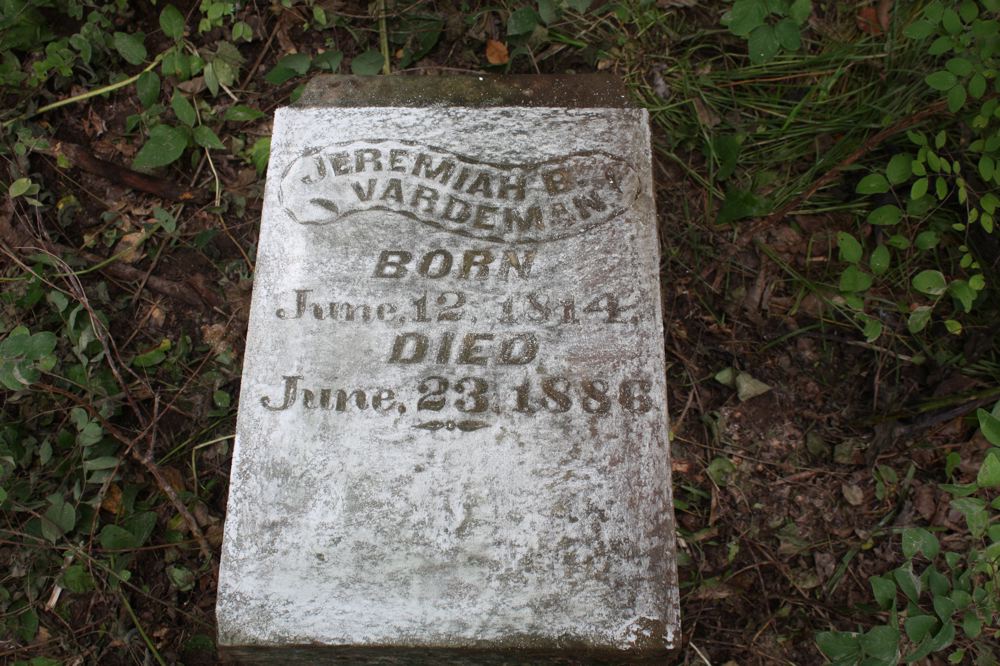
Jeremiah B Vardeman
Born June 12, 1814
Died June 23, 1886
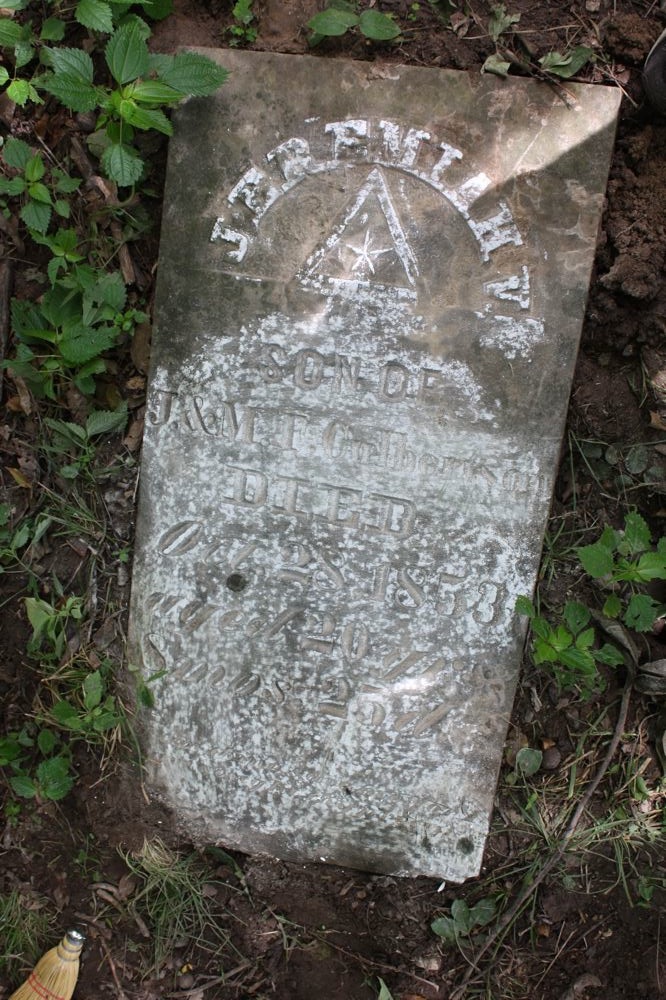
Jeremiah V.
Son Of
J.& M. F. Culberrson
Died Oct. 28, 1853
20 yrs. 8 mos. & 25 dys.
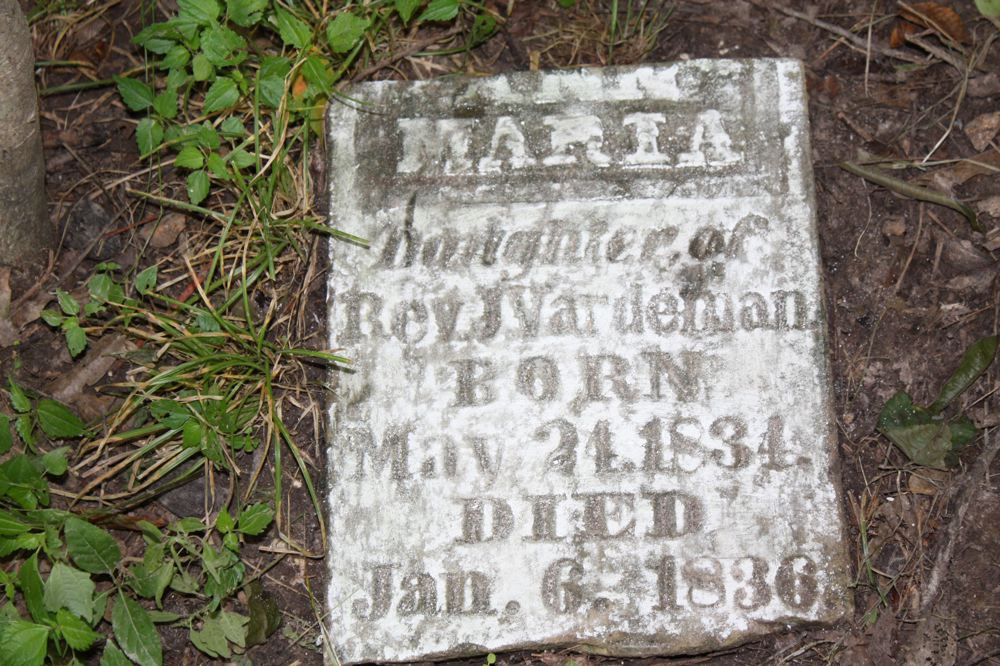
Marie
Daugther Of
Rev. J. Vardeman
Born May 24, 1834.
Died Jan. 6, 1836.
(A marker that lies flat on the ground)
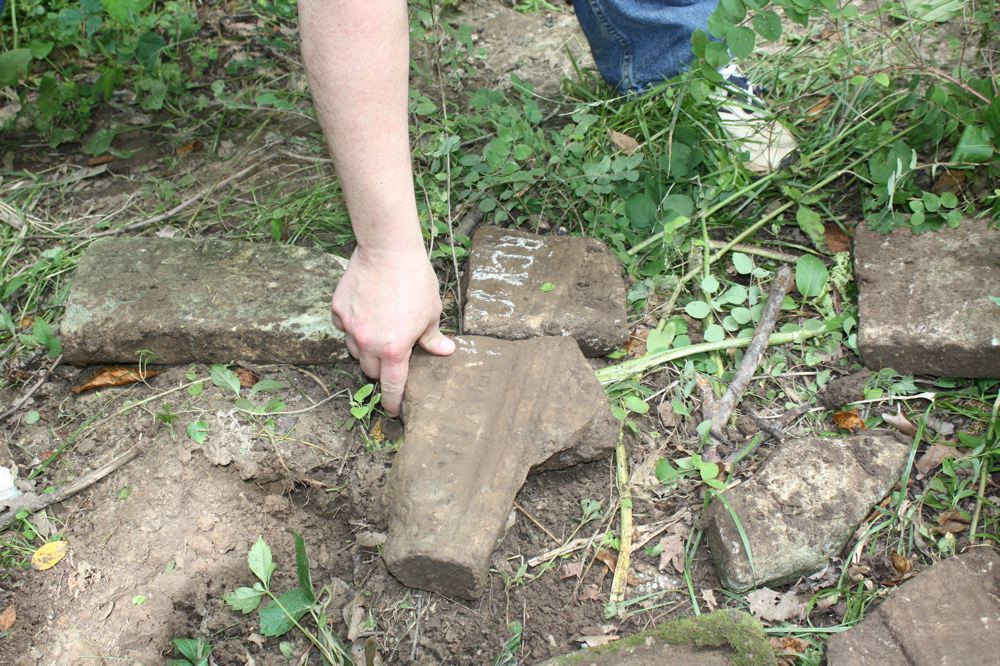
Trying To Put The Pieces Together - Literally!
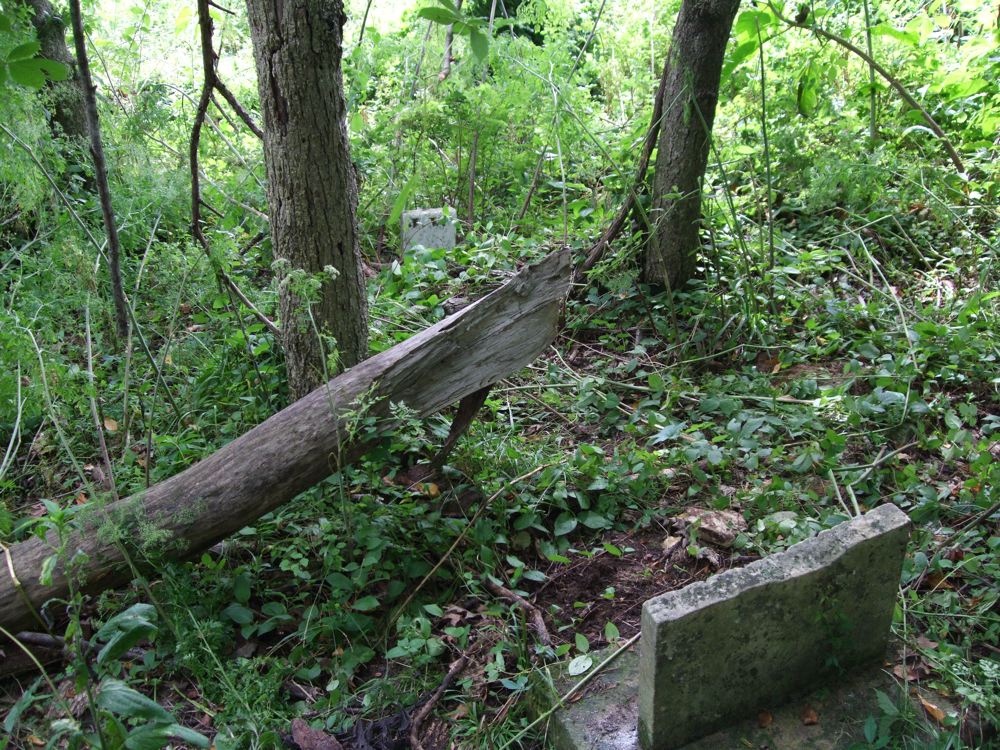
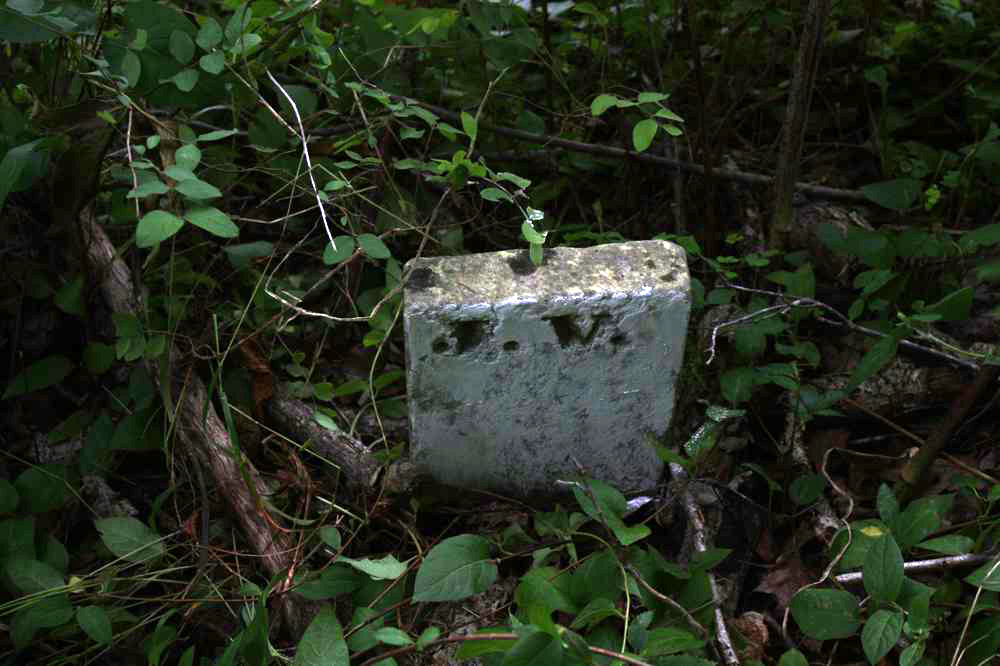
Footstone of Jeremiah Vardeman - "J.V."
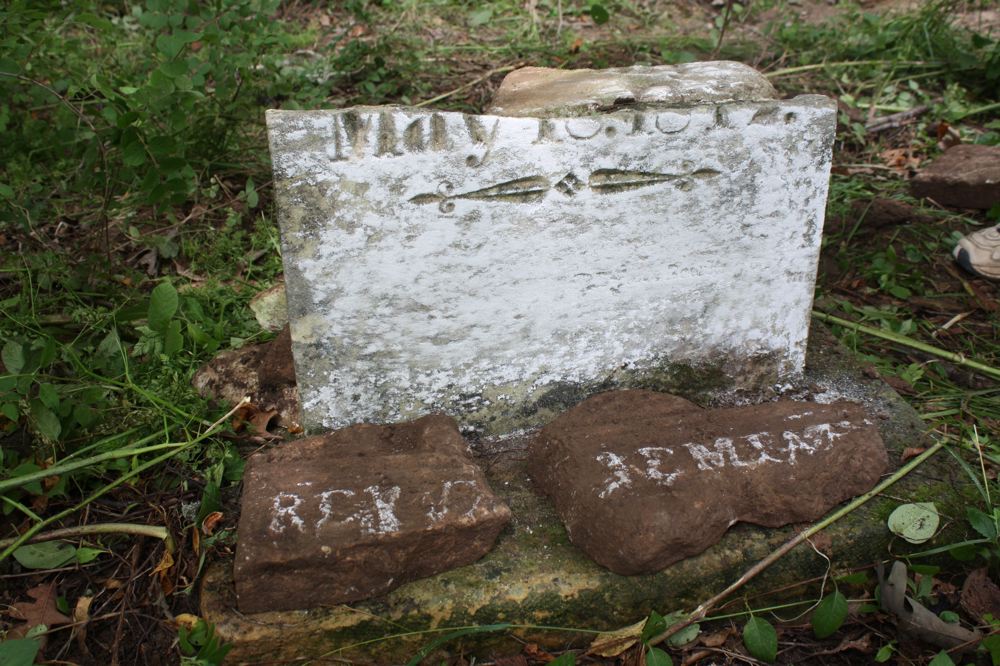
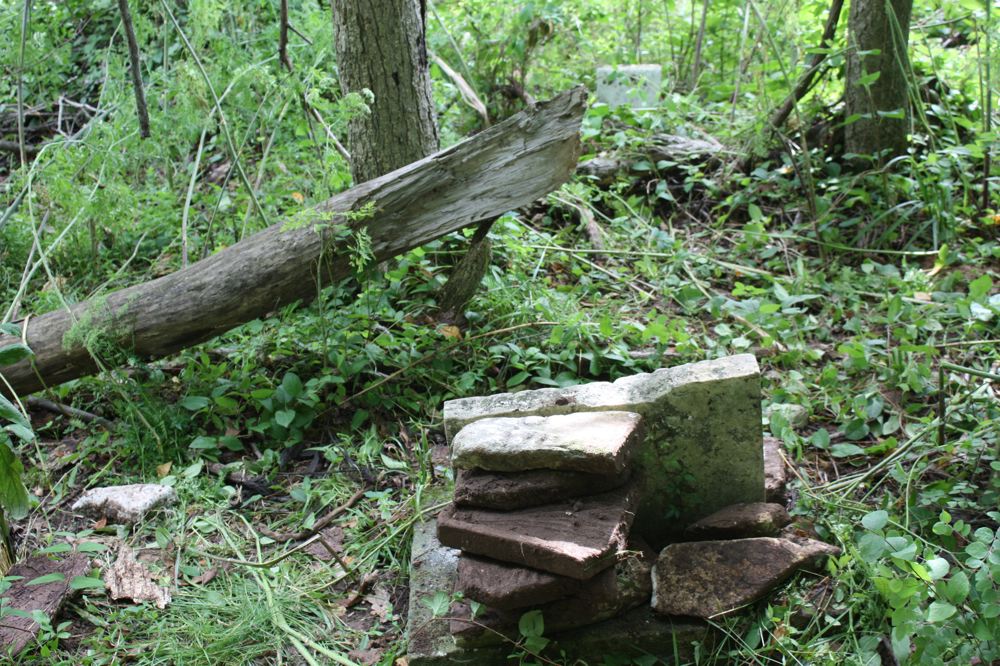
Stacked Broken Pieces Of Jeremiah Vardeman's Grave Marker
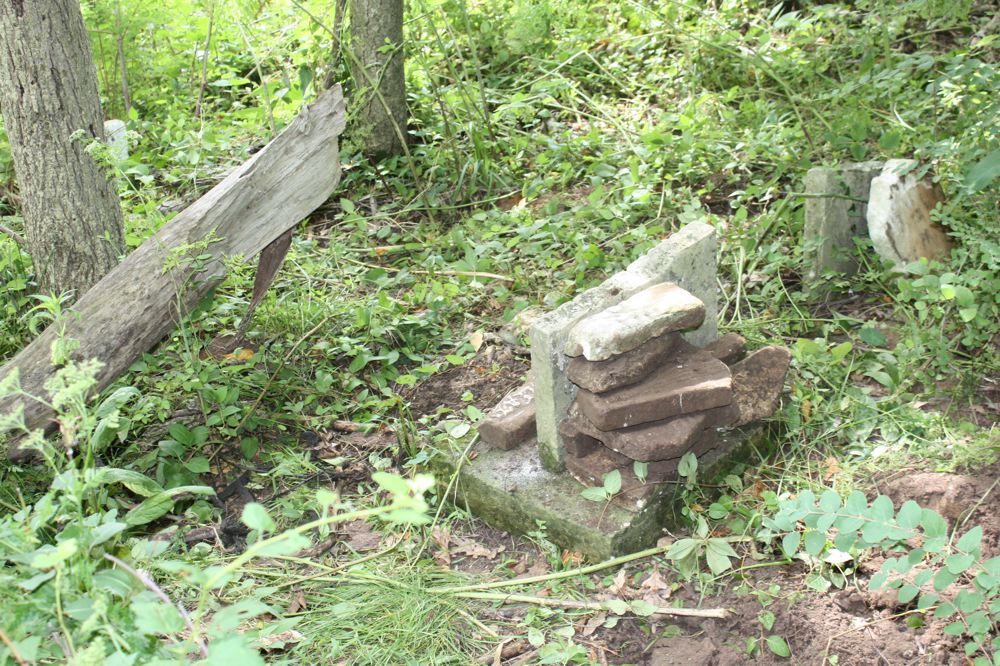
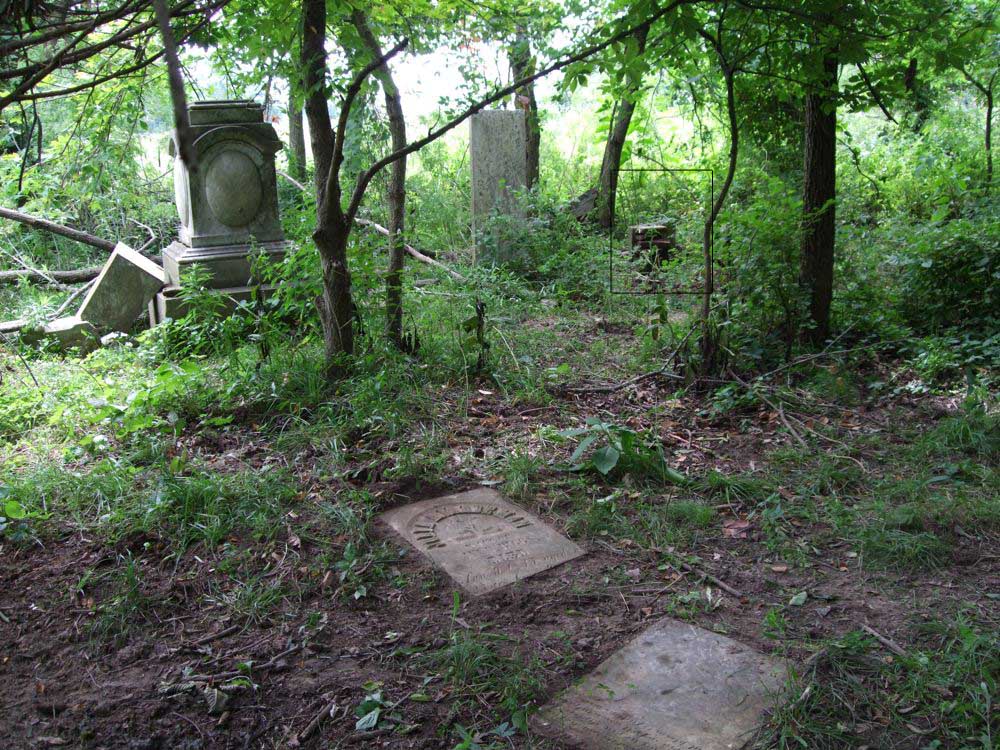
From Rear Of Cemetery Looking Back Toward Jermiah Vardeman's Grave - (Square marks J.V. Grave)
Special Thanks To Tom Childers and Wayne Kilpatrick for assisting me in locating and photographing the Vardeman Cemetery in June, 2009. Some of the photos you see on this page were taken by them.
![]()
